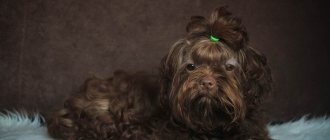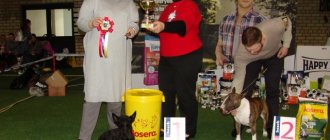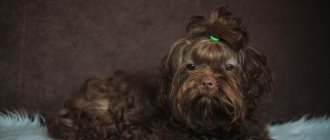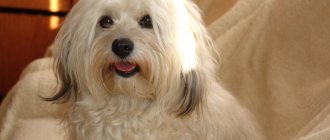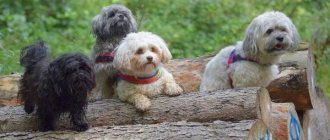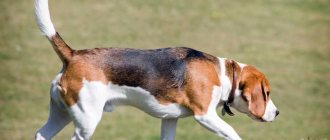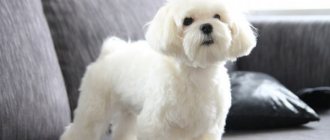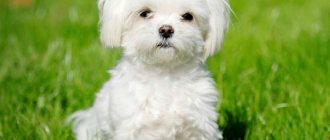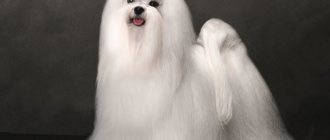History of the origin of the Russian Tsvetnaya lapdog breed
Russian Tsvetnaya lapdog - a decorative dog of domestic selection
The colored lapdog appeared in Leningrad in the middle of the last century thanks to a group of enthusiasts led by Zh. A. Chesnokova, who set out to breed small dogs for decorative purposes. Many varieties of breeds were used in the selection process. These are lapdogs, Pekingese, Shih Tzu, French lapdogs, dwarf poodles, Lhasa apsos. Mongrel dogs were also involved, which were selected because of their attractive appearance. So, in 1966, a standard was developed and approved by the Canine Council.
In the 1970s, colored lapdogs were brought to Moscow, where they took part in numerous exhibitions. The popularity of the breed increased. Nurseries were organized in Moscow. And in Leningrad during this period the situation was exactly the opposite. By the 1990s, only a few dozen individuals remained, but even these were not used for breeding. Only at the end of the century did the revival of lap dogs begin in St. Petersburg. In 1999, a club of lovers of this breed was created, which contributed to its popularization. Today, Russian colored lapdogs are also popular in foreign countries.
Important! The Russian lapdog has not yet been recognized by the FCI. According to some experts, this breed is a copy of the Italian Bolognese dog.
Kinds
There are several types of lap dogs. They are united by several parameters: miniature, friendliness and lush fur. Mostly women like to have such dogs. Let's consider the popular types of lapdogs, except Russian:
Bichon Frize. The second name of the dog is “little lion”. These are small and very fluffy dogs that resemble stuffed animals. The Bichon Frize is a good decorative breed, perfect for apartment living.
Havanskaya. This dog was bred by crossing other types from this group. He is small, has a pleasant appearance, very sweet and affectionate.
Bolognese. The dog's homeland is France. She is considered the most sociable lap dog.
Coton de Tulear. A very mischievous and nimble dog. He is filled with energy. The homeland of Coton de Tulear is the famous island of Madagascar.
Maltese. One of the oldest representatives of this group of dogs. The Maltese is very fluffy.
Levchen. The dog is very similar to a large Persian cat. He is just as graceful and fluffy. They cut it so that it resembles a decorative lion with a lush mane.
Standards
The Russian Tsvetnaya Bolonka is a small breed with a proportional build.
This is a compact dog with a harmonious build and a slightly elongated body. The main characteristics include the following:
- The height at the withers of dogs is 20–26 cm, weight is 1.5–4 kg. The length of the body must exceed the height of the animal by 15%. The chest corresponds to half the size of the dog at the withers.
- The length of the muzzle should be equal to 1/3 of the head. The dog has a round, slightly convex skull. The occipital protuberance is little noticeable. The nose is small, the earlobe can be black or have a fur color. The muzzle tapers slightly towards the nose.
- The eyes are round, dark. The ears are triangular, hanging on cartilage, the tips have a rounded shape.
- Scissor bite.
- The back is wide and level. The loin is short and has a slight convexity. The croup is wide, rounded with pronounced muscles. The chest is oval, long, reaching the elbows. The stomach is tucked.
- The shoulder blades are slightly sloping and well muscled. The paws on the forelimbs are round in shape. The thighs are muscular and slightly inclined.
- The hock joints are strong, dry, and the articulation angles are moderate. The hind legs are oval in shape and inferior in size to the forelegs. The tail is covered with long hair and curled into a ring shape.
- The skin is elastic without folds. The coat is long, thick, shiny, wavy (with different curl sizes).
- The lapdog can be gray and tan, black and tan, red, cream, brown, grey, fawn, black, but must be a solid color. Spotting is regarded as a breed defect. The standard also does not allow white color.
- Life expectancy exceeds 15 years, during which the pet does not lose interest in the outside world.
Important! A peculiarity of this breed is the change in color during the first years of life.
Bolognese
Bologneses (or French lapdogs) are smart, obedient, intelligent dogs, ideal pets, devoted to their owner.
They gained particular popularity several centuries ago in the Italian city of Bologna, which is the main reason for the name of the breed.
The European nobility showed interest in them, but with the course of historical events, the popularity of the Bolognese was lost. Thanks to the efforts and perseverance of breeders, at the beginning of the 20th century the breed began to gain demand again, although at that time there were only about a dozen Bologneses left.
The breed standard was adopted in 1995. The dog's height is 20-30 cm at the withers, weight is 4.5-7 kg. The fur is white, silky, thick, covering the entire body and the high-set tail lying on the back. The furry ears are drooping, and the eyes are dark and extremely expressive. Black nose, eyelids and lips look impressive.
Bolognese is very charming and stylish. They are distrustful of strangers, but dote on their owner.
These dogs live a long time, on average 12-14 years, have excellent health and adapt to any conditions and life situations.
French lapdogs have a fairly high intelligence index for indoor dogs.
They love attention and praise. These are the most sociable dogs from the group of lapdogs.
Character traits
The breed is distinguished by its kindness, activity and intelligence.
The Russian lap dog has a playful, soft, friendly character, which quickly wins the love of all family members. The pet becomes very attached to its owner and needs constant communication . Lack of attention can negatively affect your dog's well-being. But at the same time she is unobtrusive. Gets along well with children.
The Russian lapdog is distinguished by its extraordinary intelligence. Dog breeders note that this breed is capable of very subtly sensing the owner’s mood. If a person is in the stage of emotional depression, the pet will not bother you with its attention, but will simply lie down next to you. If there are other animals in the apartment, he will be able to find a common language with him without any problems, even if they are parrots or cats. Doesn't like to be alone.
Video: dog behavior and appearance
Beagle
"Beagle"
Dogs of the Beagle breed appeared in medieval England. The royal nobility used them to track deer and roe deer and hunt hares. This breed of small dogs instantly captivates with its remarkable charm, and their charming eyes seem to look straight into your soul, especially if the animal has set the goal of begging you for a treat. These dogs have a short and dense coat, standard height at the withers varies between 33-40 cm and a weight of 9-14 kg. Beagles have an excellent temperament - they are energetic and intelligent, playful, loyal and friendly. Their keen sense of smell can sometimes make walks especially interesting as they try to keep track of every scent they encounter.
How to choose a puppy
The breed is not numerous and today there are not many nurseries specializing in breeding colored lapdogs. Information about breeders can be found in Internet resources or at specialty exhibitions. The cost of a puppy is approximately $200. This relatively low price is explained by the fact that the breed is not recognized by the International Federation.
If you only need a lapdog as a companion, you can purchase a pet-class dog. They are sold at the age of 2-3 months. But for a show career you need a show-class puppy. It can be purchased no earlier than it reaches six months.
You can make sure that your baby has no health problems by his appearance. A healthy dog has shiny fur, a firm belly, a cool, wet nose and clear eyes. Ask the breeder for information about vaccinations and deworming of the animal. Also look at the parents, their appearance must meet the standard.
Purpose
The dog in question was bred as a decorative dog and can be used as a companion dog. They work quite well as a “bell”, notifying about the arrival of guests. Representatives of this breed are able to perfectly adapt and adapt to the character and rhythm of life of the owner .
People who have completely different temperaments and lifestyles get lap dogs:
- pensioners;
- teenagers;
- active youth;
- lonely people;
- families with children.
Dog care
This breed is specially bred for apartment living, so it does not cause much trouble.
Features of living in an apartment
Russian Tsvetnaya lapdog - a good-natured and unobtrusive pet for indoor keeping
The breed is not subject to shedding, which allows it to be kept clean and eliminates the need for regular cleaning. Since this dog needs constant attention, you should not leave it alone for a long time. She can express her dissatisfaction in the form of damaged furniture or torn wallpaper. To rest, lay a bedding for the dog in a place away from the passage.
Important! Due to the small size of the lapdog, it can be trained to use a tray, which will greatly simplify caring for your pet.
Necessary hygiene measures
Russian colored lapdog needs grooming and cutting
Despite the dog’s long coat, hygiene procedures do not require much effort. It is necessary to comb your lapdog at least 3 times a week using a massage brush. But if you have free time, the procedure can be performed daily. But you don’t need to bathe your pet more often than 1-2 times a month. Water procedures are carried out using special products designed for long-haired breeds (Bio-Groom, ALL System). After bathing, dry the coat with a towel and then use a hair dryer.
Important! If the dog participates in exhibitions, you can use a tinted shampoo for it, which helps make the color of the coat brighter and more saturated.
Other pet care measures include:
- Once every 2 weeks, trim your dog’s nails with special clippers, which can be purchased at a pet store. Otherwise, the lapdog will experience discomfort when walking.
- Long bangs can get into your dog's eyes, so they need daily care. Wipe them with a cotton pad soaked in a special lotion (Rosinka, Chamomile, Show Tech). At the same time, secure the bangs with an elastic band or a hairpin.
- Maintain your ear hygiene weekly by cleaning them with a damp cloth.
- Clean your teeth 1-2 times a week using a special paste and brush (Trixie, Ora Pet).
Pet hygiene products (photo)
ALL System shampoo is also suitable for lap dog hygiene
Shampoo for long-haired breeds is used for bathing Ora Pet dog paste will protect your pet from gum disease
Show Tech eye lotion will allow your dog to avoid discomfort and infection
Trixie offers a ready-made dog oral hygiene kit
Lotion “Rosinka” painlessly cleanses the eyes
Tips for proper nutrition
The diet of a colored lapdog should be rich in proteins and vitamins.
Dog breeders advise feeding the Russian lapdog with industrial food, but the use of natural products is also allowed.
Important! The Russian lapdog consumes quite a lot of energy compared to its weight, so it needs good nutrition with a predominance of animal proteins.
Choose premium and super-premium products for your pet. Using such food, you can provide your dog with high-quality nutrition. These include Royal Canin, Hills, Advance, Brekkies. The daily norm for a Russian lapdog is from 150 to 300 g of the mixture, depending on the age of the pet.
If you prefer to feed natural food, give your pet the following foods:
- lean meat (rabbit, poultry, veal);
- offal (lungs, stomachs, chicken hearts and liver);
- boiled sea fish;
- porridge - buckwheat, rice, millet, rolled oats;
- vegetables - carrots, beets, zucchini, cabbage (raw);
- cottage cheese, fermented baked milk, kefir, unsweetened yogurt;
- one boiled egg per week.
Avoid sausages, spices, confectionery, potatoes, legumes. The dog must also have constant access to water.
Important! Stick to a certain schedule, give your pet food at the same time.
A puppy up to 3 months is fed 5 times a day, up to 4 months - 4 times, up to 6 months - 3 times, then 2 times a day.
Important! After eating, do not take your dog out for a walk immediately; give him the opportunity to rest for about an hour.
How to walk
The colored lapdog does not require long walks
It is recommended to take your lapdog outside 1-2 times a day for 15-20 minutes. She does not need much physical activity. But thanks to its endurance, the Russian lapdog can accompany its owner on long journeys. Also, regular walks will help socialize the dog.
Important! In the cool season, it is advisable to use overalls for walks.
Video: dog behavior in nature
Nutrition
It makes no sense to say that nutrition plays almost the leading role in the formation of canine immunity. Breeders at offline meetings and on the Internet loudly argue among themselves which is better - factory feed or natural products.
Black Russian lapdog puppies
And the owner and his pet solve this issue quietly and peacefully in their kitchen. In the end, this is a purely individual matter. Is it convenient for the owner to feed the dog dry food? Great. The main thing is to ensure that the food is of high quality, and also measure doses in accordance with the standards prescribed on the packaging. Vitamins and minerals are already included in the diet, so there is no need to worry about it further. In addition, the packaging is convenient to take on trips.
Do you have enough time for daily cooking? Also a great option, although more troublesome. But there will always be variety in the bowl. The dog will happily eat meat, sea fish, vegetables, fruits, cereals, and sour milk. The lapdog especially reveres quail eggs.
In both cases, it is important to provide the dog with drinking water by placing the bowl in a place accessible to the animal. Any owner of the breed should know that Russian lapdog puppies eat up to six times the first three months, and then one feeding is removed every month. By the age of one year, the dog eats twice a day, but does not remain hungry, because the amount of food in the plate has gradually increased
By the age of one year, the dog eats twice a day, but does not remain hungry, because the amount of food in the plate has gradually increased.
The general rule for all breeders is not to feed the dog from your table, despite its sad and sad look. You should not give sweets, smoked foods, salty foods, potatoes, legumes, as well as foods that lead to gas formation.
Pregnancy and childbirth
Giving birth to a colored lapdog is an important process during which the owner must be nearby
The average duration of pregnancy for lap dogs is 56–72 days. It is advisable that the dog be observed by a veterinarian during this period. Puppies can be probed from 21 to 35 days. At week 5, the bitch’s belly is rounded and her mammary glands swell.
During the first month, there is no need to make changes to her lifestyle and nutrition system. 10 days before the onset of labor, give your dog less protein food . At 50–51 days, you can feel the puppies moving, which stops on the eve of birth. This is a completely natural process that should not cause concern.
During the birth process, the owner must be close to the female and provide the necessary assistance. Keep ready:
- clean diapers;
- napkins;
- scissors;
- brilliant green;
- threads;
- basin;
- oilcloth.
The approaching birth of a pet is accompanied by the following symptoms and manifestations:
- 24 hours before the onset of labor, body temperature drops to 37°C.
- Over the course of 4–5 days, the dog’s stomach drops and its back sags.
- At the first stage of labor, the dog begins to show anxiety: whining, scratching the floor, tearing the bedding.
- Then she takes a lying position, extends her forelimbs and lowers her head between them.
On the eve of giving birth, be sure to trim the dog's fur on the belly, around the anus and loop. If your dog has contractions, place him on an oilcloth with a cloth diaper on top. A few hours later, the bitch will lose her amniotic fluid and the puppy will appear. During the normal course of the process, it is born with its back up and its head forward.
Most dogs rupture the membranes on their own, free the puppy, and bite the umbilical cord. But if the female refuses to do this, the owner must take over this function . Compress the umbilical cord, direct blood to the baby, then cut it 2 cm from the tummy. Treat the cut area with green paint. If there is bleeding, tie the umbilical cord with a thread. Wipe your baby off the mucus and make sure he is breathing. Then place it next to the dog. If the baby's breathing is barely noticeable, rub the puppy with a terry towel. This will help stimulate blood circulation and ventilation of the lungs.
Important! The normal body temperature for a puppy is 38–39°C, the heart rate is 100–130 beats per minute, and the respiratory rate is 20–22 times.
After the birth of each puppy, the placenta should pass. Collect them in a basin, and count them at the end of the birth process. The afterbirth has nutritional value for the dog. But don't let her eat more than two, otherwise the female may vomit.
Important! The footprints must correspond to the number of puppies; if there are fewer, seek medical help.
The intervals between the birth of puppies average from 15 to 30 minutes . If after 2 hours the next baby does not appear, you should immediately call a veterinarian . After the process is complete, give your dog warm tea with milk. She will have some spotting throughout the week, but this should not alarm you.
Take care of the place where the dog will be with the puppies after they are born. It should be a clean box or bed with high sides. Be sure to line the bottom with clean sheets and provide a heating system. This could be a heating device placed next to the box, or an infrared lamp suspended above the bed.
Important! Sometimes an electric heating pad is placed under the layers of diapers, but this is not the safest method of heating, as it can cause bleeding in the bitch.
The temperature in the area designated for the dog and puppies should be maintained at +28°C in the first 10–12 days after birth, then it is gradually reduced to +20°C. Remember that both hypothermia and overheating are equally dangerous for newborn babies.
Subtleties of training and education
Russian Tsvetnaya lapdog is highly trainable
Raising a Russian colored lapdog puppy begins at an early age. From 2 months he can be accustomed to a name, place, tray. If your baby spoils furniture or chews shoes, say “No!” in a stern tone. Russian lap dogs have a developed intelligence, they are quite capable of understanding what they want from them.
Some dog breeders are of the opinion that it is not necessary to train representatives of this breed. But to facilitate interaction with a pet, it should be taught the basic commands: “Near!”, “Come to me!”, “Sit!”, “Lie down!”, “Ugh!”, “Place!”.
Possible diseases and vaccinations
The Russian Tsvetnaya lapdog is highly resistant to diseases. This is due to the fact that many mongrel dogs were involved in the breeding, which, as you know, are famous for their health. However, lap dogs are still susceptible to tearing and tartar formation. To protect the health of your pet, you need to make sure that the bangs do not get into the eyes. And also regularly take care of dental hygiene.
To prevent viral diseases, your dog must be vaccinated. Vaccination promotes the production of antigens and the formation of immunity against rhinotracheitis, rabies, leptospirosis, adenoviral hepatitis, parvovirus enteritis, and canine distemper.
Vaccinations are done according to the following scheme:
- at 8–9 weeks;
- at 12 weeks;
- at 6–7 months;
- every year throughout the life of the animal.
The formation of resistance to infections occurs within 10–14 days. Until this time, the dog’s body is susceptible to diseases, so it must be protected from infection. To do this, it is necessary to prevent the pet’s contact with other animals, as well as protect it from hypothermia and stress . 7–10 days before each vaccination, the animal is given an anthelmintic drug (Drontal Junior - 1 ml per 1 kg of body weight).
